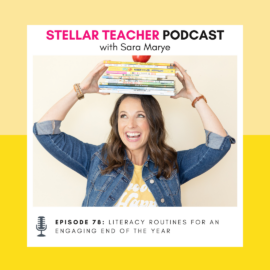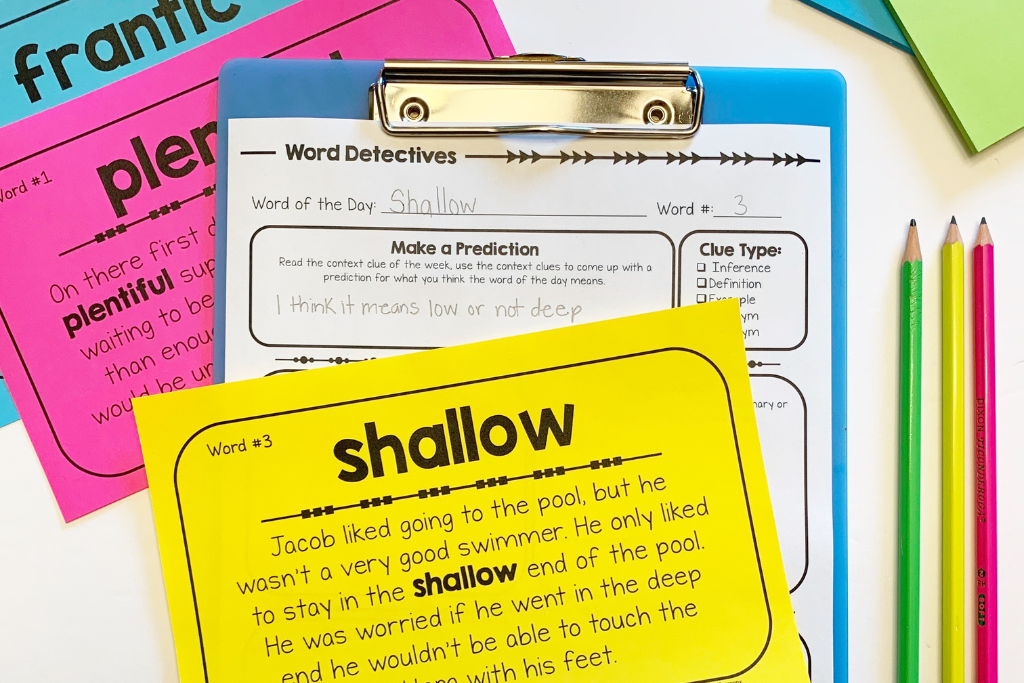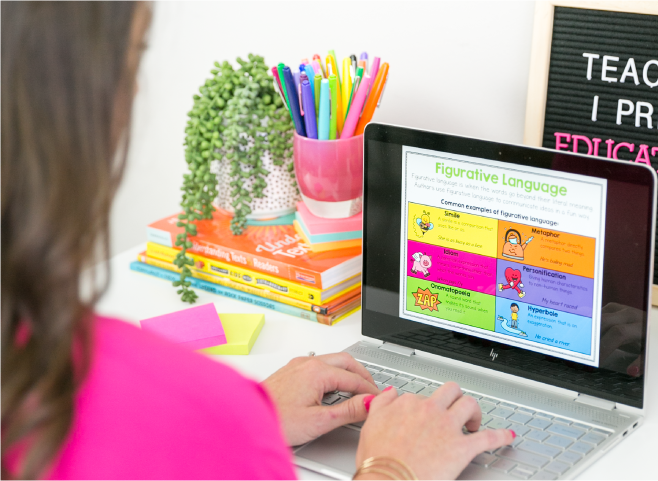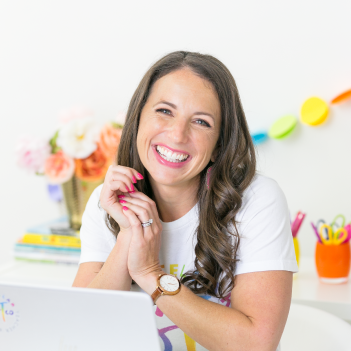
Click play below to listen to simple ways you can boost student engagement this week.
There are so many times as teachers when we realize we’re the ones doing all the heavy lifting during our lessons—talking, thinking, and writing—while our students sit back and watch. If that sounds familiar, you’re not alone. Student engagement isn’t something that happens automatically, even with a great lesson plan. In this episode, I’m unpacking what it really means to plan for engagement and why it’s essential to build intentional opportunities for students to think, respond, and connect throughout every lesson.
I share a handful of simple engagement routines that can transform the way your students interact with your lessons. These routines—like the classic think-pair-share, agree/disagree statements, two-sentence responses, and three-two-one reflections—don’t require fancy materials or major prep. Instead, they’re flexible structures that you can use in any subject to spark thinking, encourage participation, and give every student a voice in your classroom.
By the end of this episode, you’ll see how easy it can be to plan for engagement and keep your students actively involved all lesson long. My challenge for you this week is to choose one engagement routine and try it out. Start small, stay intentional, and watch how your students’ focus, confidence, and comprehension grow. Click play to discover how small, intentional changes can make a big difference in how your students show up and engage during lessons.
In this episode on student engagement, I share:
- Why student engagement doesn’t just happen—and how to plan for it intentionally
- Simple routines that get students thinking, talking, and participating
- Easy ways to weave engagement opportunities throughout your lessons
- Why variety matters when planning engagement opportunities
- Examples of low-prep engagement routines you can start using this week
- Quick routines that spark thinking and participation in any subject
Resources:
- Engagement Routine Slides on TPT
- Join The Stellar Literacy Collective
- Get the Stellar Intervention Toolkit
- Sign up for my Private Podcast: Confident Writer Systems Series
- Sign up for my FREE Revision Made Easy email series
- If you’re enjoying this podcast, please leave a review on Apple Podcasts!
Related Episodes and Blog Posts:
- Episode 170, Losing Steam Before Winter Break? Try These Fun Activities to Keep Your Class Excited About Reading
- Episode 160, 4 Movement Routines to Try in Your Upper Elementary Classroom
- Episode 132, Two Simple Ways to Boost Engagement During Whole Group Lessons
- Blog: Private: 10 Engaging Reading Response Ideas For Upper Elementary Students
Connect with me:
- Join my newsletter
- Shop my TPT store here
- Subscribe to our YouTube channel
- Instagram: @thestellarteachercompany
- Facebook: The Stellar Teacher Company
More About Stellar Teacher Podcast:
Welcome to the Stellar Teacher Podcast! We believe teaching literacy is a skill. It takes a lot of time, practice, and effort to be good at it. This podcast will show you how to level up your literacy instruction and make a massive impact on your students, all while having a little fun!
Your host, Sara Marye, is a literacy specialist passionate about helping elementary teachers around the world pass on their love of reading to their students. She has over a decade of experience working as a classroom teacher and school administrator. Sara has made it her mission to create high-quality, no-fluff resources and lesson ideas that are both meaningful and engaging for young readers.
Each week, Sara and her guests will share their knowledge, tips, and tricks so that you can feel confident in your ability to transform your students into life-long readers.
Tune in on your favorite podcast platform: Apple, Google, Amazon, Spotify, Castbox, and more! If you’re loving this podcast, please rate, review, and follow!
Podcast (stellar-teacher-podcast): Play in new window | Download
Hey there, stellar teachers. Welcome back to another episode of The Stellar Teacher Podcast. I’m your host, Sara Marye.
Now, how many of you feel like you’re doing the majority of the heavy lifting during your lessons? Like, if you step back and think about it, you’re more engaged in the lessons than your students are.
I know I felt like that oftentimes in my classroom. It’s like I’m doing more talking, I’m doing more writing, I’m doing more thinking—and it was a lot of work for me. And really, it shouldn’t be that way. But we’ve all been there.
It’s probably not because your lessons aren’t strong. It’s probably because you’re assuming that engagement will just happen. We think that if we plan a really great lesson, our students will automatically be engaged. And some of them will be. But we want 100% of our students engaged.
The reality is that engagement is something we need to plan for—especially when our students’ attention is being pulled in a million different directions like it is today.
So we really need to be intentional about planning engagement opportunities throughout our lessons that will bring students’ attention back to what we’re teaching.
In today’s episode, we’re talking all about engagement routines—what they are, why they matter—and I’ll share a few simple ones that you can use to get your students thinking, reflecting, writing, and interacting with each other and with your lessons starting this week.
And spoiler alert, these routines aren’t difficult. They don’t require a ton of prep, new resources, or a complete lesson overhaul. They’re small, simple things that you can literally apply to any lesson in any subject.
Now, like I said, engagement doesn’t just happen. We have to plan for it.
Sometimes we think that if a text is interesting or if a lesson is hands-on, that will be enough to keep students focused and thinking. But engagement isn’t just about attention or focus—it’s about giving our students opportunities for cognitive processing.
Are our students interacting with the content? Are they connecting, responding, questioning, and reflecting on what they’re learning?
And if we’re not prompting them to do those things, chances are they probably aren’t doing them to the level or degree that we want them to. That kind of engagement requires intentionality.
So when we plan for engagement, even something as small as a sentence stem or prompting a turn-and-talk can really help students think more deeply about what they’re learning.
It also gives all students a chance to process and participate—not just the ones who always raise their hand.
Because I know when I’d go for a class discussion and say, “Raise your hand if you know,” it was always the same three or four kids who were actively engaged and participating.
So we need to be intentional about including routines and structures that get all kids participating. If you want your students to be more involved, more vocal, and more reflective, then really think about how you’re building in those opportunities for that kind of thinking throughout your lesson.
We really need to be putting two or three of these engagement routines into every lesson. It’s not just about saying, “Okay, here’s one engagement opportunity at the end.” It’s about asking, “How are we building these things in throughout our lessons?”
And the other thing to keep in mind is really being intentional and mindful about using a variety of engagement routines or thinking routines. I’m going to share a couple here in a minute, but you heard me mention using “turn and talk” as an engagement routine.
We love the turn and talk. It was one of my favorite go-tos. It’s something that we did every single day in my classroom. But it can also be really easy to fall into the trap of using the same engagement routine over and over and over again.
The problem is that when we do that, it can lead to what I call passive engagement. That’s because students know exactly what’s coming next, and they sometimes go on autopilot.
So if we’re doing a million turn and talks a day, it just becomes background noise. Students don’t spend as much time thinking about it. They sort of get burnt out on always sharing with their partner.
So we want to have a variety of these routines. Now, of course, turn and talks are great—we want to include them—but we don’t want to rely only on turn and talk.
We want to have a variety of different engagement or thinking routines so that we can rotate between them. We can have verbal ones, visual ones, and written ones. When we do that, we’re reaching different learners and keeping the classroom energy up. Plus, it teaches students that there are many ways to reflect and respond.
And once you introduce a few of these routines, you can use them again and again across your literacy block or any other subject that you teach.
So let me share a few ideas for engagement routines that work with any subject.
A really easy one is to give your students a three-two-one reflection. This is something you can do at the end of a lesson. You ask students to share three things they learned, two connections they made, and one question they still have.
They have to think about, “What did I learn? What does that connect to? And what am I still wondering?” It’s a great way to end a lesson, but it’s also really easy to adapt. You can use it at the beginning of a lesson as a way to activate background knowledge.
Not only does it encourage reflection, but it also gets students writing—and it gives you an opportunity to collect formative data. It’s a super easy routine that works with any lesson.
Another option is to give students a two-sentence response prompt. It’s super simple. All you do is ask a question, and students have to answer in one or two complete sentences.
The reason this routine is so effective is because it forces students to be precise, which means they really have to think about the language they’re going to use. And because it’s short, it’s easy to squeeze in even when time is tight.
You could use this at the start of a lesson to activate prior knowledge, during a read-aloud to check comprehension, or at the end of a lesson as a quick exit ticket.
Again, you’re simply asking a question and having students write their response. Rather than always relying on a verbal discussion, this brings the discussion to paper—and all students are involved.
Some examples of questions you could ask are:
“What do you already know about this topic?”
“What was the main idea of the passage?”
“Why do you think the character acted like that?”
And again, they can only answer in one or two sentences, but even though it’s short, it can give you a lot of information about what they do or don’t understand.
Now, another one of my favorites—and I think I mentioned this in a recent podcast episode—is using “I agree” or “I disagree” statements.
This is a great activity to use as a pre-reading strategy or as a way to activate background knowledge. You give students a bold or thought-provoking statement related to the theme or topic, and their job is to decide if they agree or disagree with that statement and explain why.
This strategy sparks critical thinking, and it’s something you can use with fiction, nonfiction, reading, writing, math, or science—it works in any subject.
For example, let’s say you’re reading a story about teamwork. You might say, “Group work always makes a task easier.” Some students are going to agree. Others are totally going to disagree. And either way, there’s no right or wrong answer, but it’s going to prompt a rich discussion and maybe give you a peek into what your students already believe or know—which can help you guide the discussion around the text.
So another classic, and one that I love, is the think-pair-share. This one is fast, it’s flexible, and again, every student gets to participate. It also encourages classroom collaboration and community.
Here’s how it works. You pose a question or a prompt related to your lesson, and then you give students a minute to think about their answer—which I think is so important.
I’m someone who is a very fast processor. When people ask a question, I can quickly come up with an answer. But the reality is not everyone is a fast processor. Some students need more time to formulate their thoughts.
That’s why the “think” part of the activity—think, pair, share—is so valuable. It creates space for students who might not have an immediate answer right away. And I think this is especially important for students who are hesitant to join group discussions or the ones who don’t always raise their hand. It gives them time to really think about their answer and be prepared to participate.
So, give students a minute to think about their response. Then they’re going to pair with a partner or a small group to share their thinking. You can have students do this orally, or they can write it down first.
After they’ve paired, it’s time to share. You can invite a few students—or one from every group or partnership—to share with the whole class.
This way, students get time to think, everyone participates during the pair step, and then you hear from a sampling of the class when it’s time to share.
Simple and super effective. Think-pair-share works with any subject. It’s great during a read-aloud—you could use it to reflect on a character’s choices. You could use it in small groups to discuss a nonfiction fact or a piece of information students are reading about. You could use it at the end of a lesson to have students summarize what they learned.
Again, it only takes a few minutes, but every student is participating and engaged.
So those are just a couple of examples. There are so many more, but hopefully what you’ve realized is that engagement doesn’t have to be elaborate. It doesn’t need to be super complicated. It just needs to be intentional.
When you incorporate engagement routines or thinking routines—like some of the ones I shared today—and make them a regular part of your instruction, your students will become more reflective, which ultimately means they’ll become more confident and more involved in their learning.
My goal for you this week is to pick just one of the routines and try it out. Maybe write a few agree or disagree statements before your next read-aloud. Maybe end your next small group with a three-two-one reflection. Whatever it is, just get started.
Because once you start incorporating different routines in your classroom, it becomes easy to pull them out of your back pocket anytime you notice a lull in engagement.
If you’re looking for more engagement strategies like the ones I mentioned, we have a set of engagement and movement activities that are both included in The Stellar Literacy Collective. We also have them available in our Teachers Pay Teachers store. I’ll link to those in the show notes.
They’re a set of slides that explain how to do each activity. You just pop the slide up—whether it’s during your read-aloud or your science lesson—and follow the directions. You’ll just need to supply your specific prompt, but the slides explain the structure of the thinking routine, making it an easy way to add these activities into your lessons.
So check out the link in the show notes if that’s something you’d like to explore.
And of course, thank you so much for tuning in today. If this episode sparked an idea or helped you rethink your engagement strategy in your classroom, I’d love for you to share this episode with a teacher friend. Or you can always leave a review and tell us about it on Apple or Spotify.
I hope you have a great week, and I’ll see you back here next Monday.








Leave a Comment
You must be logged in to post a comment.